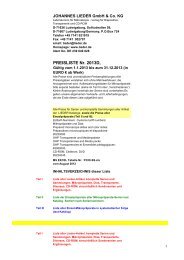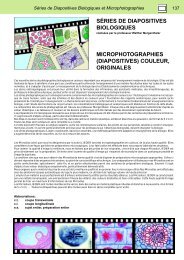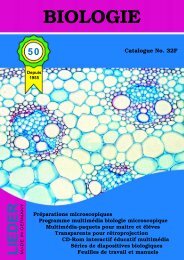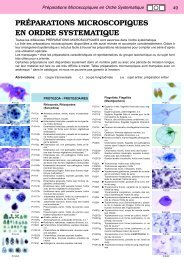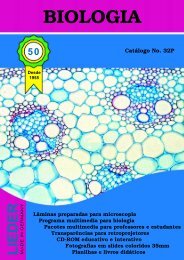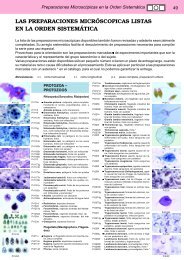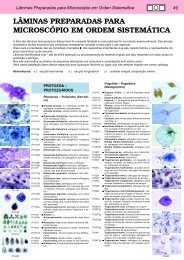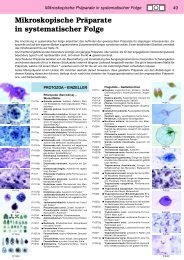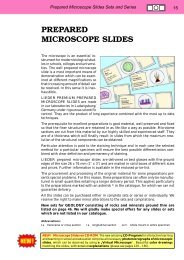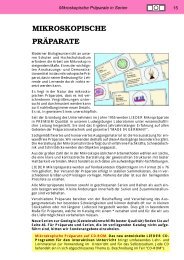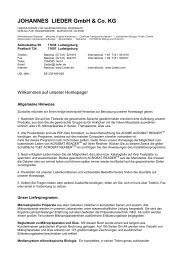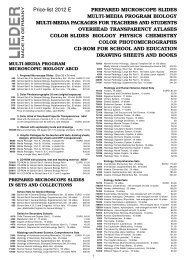Prepared Microscope Slides in Systematic Order - lieder.de
Prepared Microscope Slides in Systematic Order - lieder.de
Prepared Microscope Slides in Systematic Order - lieder.de
Create successful ePaper yourself
Turn your PDF publications into a flip-book with our unique Google optimized e-Paper software.
84<br />
<strong>Prepared</strong> <strong>Microscope</strong> <strong>Sli<strong>de</strong>s</strong> <strong>in</strong> <strong>Systematic</strong> <strong>Or<strong>de</strong>r</strong><br />
LIST OF CONTENTS: PREPARED MICROSCOPE SLIDES IN SYSTEMATIC ORDER<br />
Protozoa page 49<br />
Rhizopoda (Sarcod<strong>in</strong>a) 49<br />
Flagellata (Mastigophora) 49<br />
Sporozoa 50<br />
Ciliata (Infusoria) 50<br />
Mesozoa 50<br />
Porifera – Sponges 50<br />
Coelenterata 51<br />
Plathelm<strong>in</strong>thes – Flatworms 51<br />
Turbellaria – Turbellarians 51<br />
Tremato<strong>de</strong>s – Flukes 51<br />
Cesto<strong>de</strong>s – Tapeworms 52<br />
Nemathelm<strong>in</strong>thes – Roundworms 52<br />
Acanthocephala 53<br />
Annelida – Annelids, Diverse 53<br />
Onychophora 54<br />
Rotatoria – Rotifers 54<br />
Bryozoa – Moss Animals 54<br />
Crustacea – Crustaceans 54<br />
Arachnida – Chelicerates 54<br />
Myriapoda – Myriapods 55<br />
Insecta – Insects 55<br />
Microscopic anatomy and histology 55<br />
Head and mouth parts, whole mounts 55<br />
Head and mouth parts, sections 55<br />
Antennae 55<br />
Legs 55<br />
W<strong>in</strong>gs 55<br />
Cytology 56<br />
Organs of metabolism 56<br />
Reproductive system 56<br />
Sense organs and nervous system 56<br />
Miscellaneous 56<br />
Whole mounts of entire <strong>in</strong>sects 56<br />
Apterygota 56<br />
Ephemeroi<strong>de</strong>a 56<br />
Diptera 56<br />
Aphaniptera 57<br />
Blattoi<strong>de</strong>a 57<br />
Hymenoptera 57<br />
Anoplura and Mallophaga 57<br />
Heteroptera 57<br />
Homoptera 57<br />
Diverse or<strong>de</strong>rs 57<br />
Mollusca – Mollusks 57<br />
Ech<strong>in</strong>o<strong>de</strong>rmata 58<br />
Enteropneusta 58<br />
Tunicata – Ascidians 58<br />
Acrania – Cephalochordates 58<br />
Pisces – Fishes 59<br />
Cyclostomata – Yawless fishes 59<br />
Selachii – Cartilag<strong>in</strong>ous fishes 59<br />
Teleostei – Bony fishes 59<br />
Amphibia – Amphibians 59<br />
Reptilia – Reptiles 60<br />
Aves – Birds 60<br />
Histology of Mammalia 61<br />
Cytology 61<br />
Epithelial tissues 61<br />
Connective and support<strong>in</strong>g tissues 61<br />
Muscle tissues 62<br />
Circulatory system 62<br />
Respiratory system 62<br />
Lymphatic system 62<br />
Endocr<strong>in</strong>e glands 62<br />
Digestive system 62<br />
Excretory system 63<br />
Reproductive system page 63<br />
Nervous system 63<br />
Organs of sense 64<br />
Integument (Sk<strong>in</strong>) 64<br />
General view of mammalian histology 65<br />
Normal Human Histology 65<br />
Epithelia and cytology 65<br />
Connective and support<strong>in</strong>g tissues 65<br />
Muscle tissues 65<br />
Circulatory system 65<br />
Respiratory system 65<br />
Lymphatic system 65<br />
Endocr<strong>in</strong>e glands 66<br />
Digestive system 66<br />
Excretory system 66<br />
Reproductive system 66<br />
Nervous system 66<br />
Organs of sense 67<br />
Integument (Sk<strong>in</strong>) 67<br />
Human Pathology 67<br />
Lung and trachea 67<br />
Blood, spleen and lymph system 67<br />
Heart and vessels 67<br />
Glands 67<br />
Intest<strong>in</strong>al tract 67<br />
Liver 67<br />
Kidney and ur<strong>in</strong>ary organs 67<br />
Reproductive organs 68<br />
Nervous system 68<br />
Sk<strong>in</strong>, locomotor system 68<br />
Embryology 68<br />
Embryology of the mussel (Bivalvia) 68<br />
Embryology of <strong>in</strong>secta 68<br />
Embryology of the sea-urch<strong>in</strong><br />
(Psammech<strong>in</strong>us miliaris) 68<br />
Embryology of the starfish<br />
(Asterias rubens) 69<br />
Embryology of the Amphioxus<br />
(Branchiostoma lanceolatum) 69<br />
Embryology of the frog (Rana) 69<br />
Embryology of the chicken (Gallus) 69<br />
Embryology of the mammalia<br />
(Pig, Sus scrofa) 70<br />
Bacteria 70<br />
Spherical bacteria, cocci 70<br />
Rod-shaped bacteria, non spore-form<strong>in</strong>g,<br />
gram-positive 70<br />
Rod-shaped bacteria, non spore-form<strong>in</strong>g,<br />
gram-negative 70<br />
Rod-shaped bacteria, spore-form<strong>in</strong>g (bacilli) 71<br />
Spiral bacteria and spirochaetes 71<br />
Miscellaneous groups 71<br />
Typical bacteria, composite sli<strong>de</strong>s 71<br />
Cytological sli<strong>de</strong>s, special sta<strong>in</strong><strong>in</strong>g 71<br />
Algae 71<br />
Cyanophyceae – Blue-green algae 71<br />
Diatomeae – Diatoms 72<br />
Conjugatae 72<br />
Chlorophyceae – Green algae 72<br />
Chrysophyceae – Gol<strong>de</strong>n algae 72<br />
Charophyceae – Stoneworts 72<br />
Phaeophyceae – Brown algae 72<br />
Rhodophyceae – Red algae 73<br />
Fungi 73<br />
Myxomycetes – Slime fungi 73<br />
Phycomycetes – Algalike fungi 73<br />
Ascomycetes – Sac fungi 73<br />
Basidiomycetes – Club fungi page 74<br />
Lichenes – Lichens 74<br />
Bryophyta – Mosses 74<br />
Hepaticae – Liverworts 74<br />
Musci – True Mosses 74<br />
Pteridophyta – Ferns and Fern Allies 75<br />
Psilotales – Psilopsids 75<br />
Lycopodiatae – Clubmosses 75<br />
Equisetatae – Horse-tails 75<br />
Filicatae – Ferns 75<br />
Gymnospermae – Gymnosperms 76<br />
Angiospermae – Angiosperms 77<br />
Cytology and tissues 77<br />
Cell nucleus, cell division, chromosomes 77<br />
Cell organelles 77<br />
Reserve and storage substances 77<br />
Crystals and metabolic products 77<br />
Meristematic tissues 77<br />
Support<strong>in</strong>g tissues 77<br />
Conduct<strong>in</strong>g tissues 77<br />
Epi<strong>de</strong>rmal tissues 78<br />
Special cells and tissues 78<br />
Roots 78<br />
Typical roots <strong>in</strong> comparison 78<br />
Root tips, root <strong>de</strong>velopment 78<br />
Typical monocot roots 78<br />
Typical dicot roots 78<br />
Adaptation to water: Hydrophytes and<br />
hygrophytes 78<br />
Adaptation to dry habitat: Xerophytes 78<br />
Adaptation to unusual mo<strong>de</strong>s of nutrition 78<br />
Stems 79<br />
Typical stems <strong>in</strong> comparison 79<br />
Typical monocot stems 79<br />
Typical dicot stems: Herbaceous plants 79<br />
Typical dicot stems: Shrubs and trees 79<br />
Stems of selected useful plants 79<br />
Adaptation to water: Hydrophytes and<br />
hygrophytes 80<br />
Adaptation to dry habitat: Xerophytes 80<br />
Adaptation to unusual mo<strong>de</strong>s of nutrition 80<br />
Petioles and miscellaneous 80<br />
Leaves 80<br />
Typical leaves <strong>in</strong> comparison 80<br />
Leaf epi<strong>de</strong>rmis and stomata 80<br />
Leaf hairs and emergences 81<br />
Typical monocot leaves 81<br />
Typical dicot leaves 81<br />
Adaptation to water: Hydrophytes and<br />
hygrophytes 81<br />
Adaptation to dry habitat: Xerophytes 81<br />
Adaptation to unusual mo<strong>de</strong>s of nutrition 81<br />
Leaf buds, leaf jo<strong>in</strong>ts, leaf abscission 81<br />
Flowers and Fruits 82<br />
Microspore <strong>de</strong>velopment <strong>in</strong> Lilium 82<br />
Pollen types 82<br />
Fertilization 82<br />
Megaspore <strong>de</strong>velopment <strong>in</strong> Lilium 82<br />
Ovaries, ovules and embryos (monocot) 82<br />
Ovaries, ovules and embryos (dicot) 82<br />
Flowers and floral diagrams (monocot) 82<br />
Flowers and floral diagrams (dicot) 83<br />
Simple fruits 83<br />
Aggregate fruits 83<br />
Seeds 83<br />
Ultrath<strong>in</strong> Sections 83



